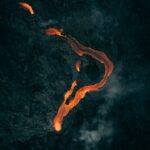Wildfires Ravage Tenerife, Threatening Lives and Land
In recent days, the picturesque island of Tenerife, a popular holiday hotspot in the Canary Islands, has been engulfed in a devastating wildfire. The blaze, described by President Fernando Clavijo as the most complicated in the region in the last 40 years, has forced the evacuation or confinement of nearly 8,000 residents. The fire, which started on Tuesday, has already destroyed over 3,273 hectares of land and continues to spread rapidly, with a perimeter of approximately 40km. As firefighters and members of the Spanish army battle the flames, the severity of the situation has prompted concerns about the well-being of both the locals and the island’s vibrant ecosystem.
Unprecedented Destruction and Human Impact
The scale and intensity of the Tenerife wildfire have surpassed all previous blazes on the Canary Islands. The fire has ravaged eight municipalities, including Arafo, Candelaria, El Rosario, La Orotava, Santa Úrsula, La Victoria, El Sauzal, and Tacoronte. With thick smoke and towering flames encroaching upon their homes, residents have been forced to flee, leaving behind their belongings and the familiar landscapes they cherish. The psychological distress caused by the fires cannot be overstated. Alba Gil, a resident of the village of La Esperanza, described the suffocating effect of the smoke, which has made breathing difficult and left residents worried about their safety throughout the night. It is a testament to the resilience of the people that they are staying strong in the face of such adversity.
Environmental Impact and the Fragility of Nature
The ecological consequences of the Tenerife wildfire are far-reaching and will have long-lasting effects on the island’s delicate ecosystem. The fire has burned a forested area characterized by steep valleys, making it difficult for firefighters to control the flames. This habitat is home to numerous species of plants and animals, many of which may not survive the inferno. The destruction of vegetation also threatens the stability of the soil, increasing the risk of landslides and erosion. Additionally, the fire’s proximity to the Teide National Park, one of Tenerife‘s top tourist attractions, has prompted its closure and the evacuation of surrounding tourist facilities. The impact on tourism, a significant source of revenue for the island, will be considerable.
Editorial: The Urgency for Climate Action
The devastating wildfires in Tenerife serve as a stark reminder of the urgency in combating climate change. The fires, fueled by extreme temperatures that exceeded 40 degrees Celsius, are part of a concerning pattern of heatwaves sweeping across southern Europe. The effects of climate change are no longer distant threats but tangible realities that demand immediate attention. As our planet continues to warm, these extreme weather events, which endanger lives and ecosystems, will become more frequent and severe.
This crisis should prompt governments and individuals alike to prioritize sustainable practices and policies. Renewable energy sources, such as solar and wind, must be embraced on a global scale. Efforts to reduce greenhouse gas emissions and transition to a low-carbon economy must be accelerated. Additionally, investing in fire prevention and response systems should be a priority, allowing for better preparedness and swift action when wildfires occur.
Advice for Tenerife and Beyond
In the aftermath of this devastating wildfire, there are important lessons to be learned. Tenerife and other regions prone to wildfires should prioritize measures to prevent and mitigate such disasters. This includes implementing effective fire management strategies, such as creating fire breaks, improving early warning systems, and increasing the capacity and resources of firefighting teams.
Communities should also be encouraged to take part in fire prevention efforts. The education and awareness of residents are vital in reducing the risk of wildfires. Teaching people about fire safety, responsible land management, and the importance of reporting potential fire hazards can make a significant difference.
Moreover, this crisis serves as a call to action for individuals around the globe. It is our collective responsibility to combat climate change and protect our planet. We can make a difference by adopting sustainable practices in our daily lives, reducing our carbon footprint, and supporting policies that prioritize environmental preservation.
The devastation in Tenerife is a painful reminder of the destructive force of wildfires and the urgent need for action. Let us not wait for further disasters before we take meaningful steps to protect our planet and secure a sustainable future for all.

<< photo by Gaurav Joshi >>
The image is for illustrative purposes only and does not depict the actual situation.
You might want to read !
- The Resurrection of Bonnie Prince Charlie: Unveiling His Face Through Death Masks
- Bonnie Prince Charlie: Unveiling the Face of the Jacobite Rising through Forensic Reconstruction
- Editorial Exploration: The importance of Shankland to Hearts’ success and the consequences of losing him
Title: The Indispensable Shankland: Why Hearts’ Can’t Afford to Lose Their Talisman
- Tenerife Inferno: Evacuation Chaos Engulfs Spanish Island
- Fighting for the Stars: Jermell Charlo’s Ambitious Quest to Challenge Canelo Alvarez
- Blazing Havoc: Devastating Wildfires Engulf Yellowknife, Canada, Displacing 20,000 Residents
- Restoring the Spirit of Harlow: Revitalizing Signage for a Vibrant Community
- “Race Against the Flames: Yellowknife Residents Flee, Traffic Gridlock Ensues”




